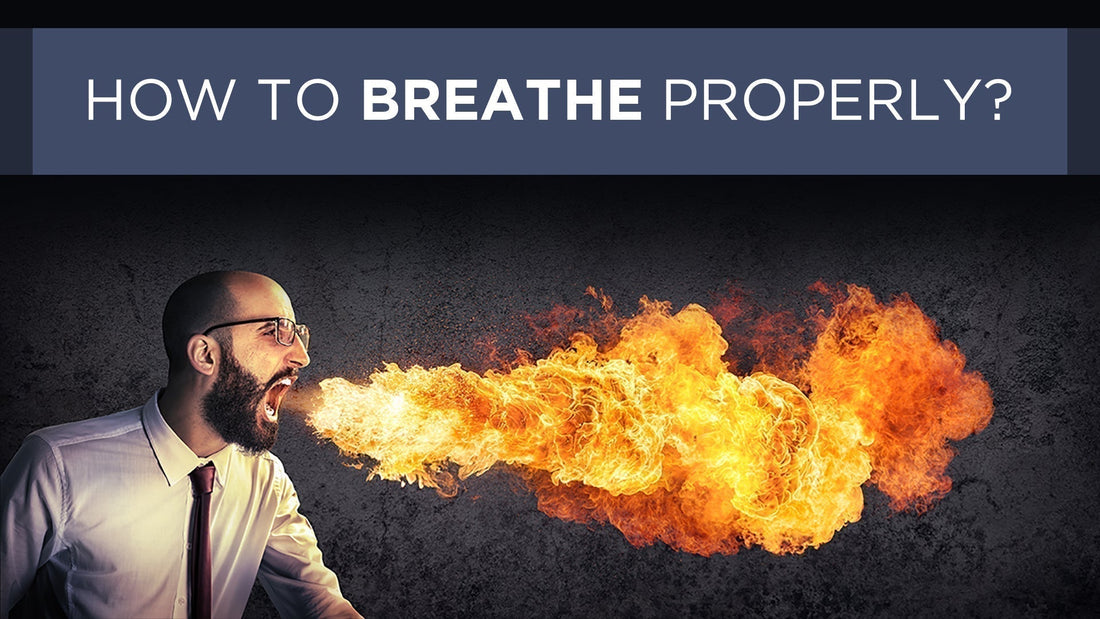
How to breathe properly?
Since breathing is an automatic function, why should we care about it? Shouldn’t it take care of itself? Well, since we breathe so much – up to 1,000 breaths per hour, 20-25,000 breaths per day, our daily breathing habits have a huge impact on every single aspect of our lives.
Our breathing is a direct reflection of what’s going on inside of us – mentally, emotionally, and physically. If we start to breathe faster other organs will follow. Our heart will beat faster. Our brain and nervous system will move into a state of stress, activity, and fight and flight. If, on the other hand, we slow down our breathing the heart and brain will follow and calm down.
When we are stressed, anxious, and worried our breathing is typically fast, shallow, irregular, big, tense, noisy, through the mouth. Many people are in this state way too often for too long and desperately seeking tools to help them find their inner calm. If we want to change from a state of stress and calm down, we can simply change our breathing and do the opposite:
The seven breath keys to calm your nervous system

Apply these seven habits whenever you want to find your inner calm and experience more harmony. The easiest way to achieve this is to close your mouth and make the exhale longer than the inhale.
-
1. Nose – Calm breathing starts in your nose. The mouth is for eating and talking while the nose is for breathing. In the nose, the inhaled air is prepared for the lungs, as it is heated, moisturized, and cleansed from bacteria, viruses, and other particles in the air before traveling down through the airways all the way to the lungs. On exhalation, the nose is reheated and remoisturized because the air coming up from the lungs is body-tempered and 100% humid. The particles that get trapped on inhalation follow the air out again during exhalation. When we breathe through the mouth, we absorb air that is cold, dry, and full of particles, making the airways irritated, inflamed, and narrow. So, in summary, we should strive to breathe in and out through our nose as often as possible.
-
2. Diaphragm – Our breathing should reach the lower part of our lungs, which will activate the diaphragm, our main breathing muscle. The diaphragm and the heart are the only muscles in our body that never rest, they are constantly active 24/7, from the day we are born to the day we die. The diaphragm is a dome-shaped muscle, much like an umbrella. As we inhale, the diaphragm moves downward and expands in all directions – forward, sideways, and back. Diaphragmatic breathing is low and wide. Breathing using your diaphragm means minimum muscle activity to move the air in and out of the lungs. Since we breathe so much it must be done as efficiently as possible, otherwise we waste unnecessary energy. The opposite of diaphragmatic breathing is shallow breathing, which is very inefficient and often associated with stress and pain in the back, neck, shoulders, and head.
-
3. Slow – A healthy breathing rate is slow with about 10-12 breaths per minute. However, many of us tend to breathe at a much faster rate which is associated with stress, poor oxygenation, and inflammation. When counting the number of breaths on people, without them knowing, we have found that most people take about 18-25 breaths per minute.
-
4. Small – A normal breath, at rest, contains only about 0.5 liters of air, equaling a respiratory volume of about 5-6 liters per minute (10-12 breaths per minute and 0.5 liters per breath). Since many of us tend to both take bigger breaths and breathe faster, it is common with a breathing volume of 10-15 liters of air per minute, which exceeds our body’s need by 2-3 times. This creates an imbalance in our body between oxygen, too much, and carbon dioxide, too little.
-
5. Rhythmic – How do you breathe when you concentrate, text, or in front of the computer? Commonly, we hold our breaths in these situations. When we start to breathe again, we will compensate by breathing faster, i.e. over-breathing. This shift, between breath-holds and over-breathing, is like a bumpy car ride where we have the foot on the gas pedal one second and on the brake the next. At night we call holding our breath for sleep apnea and it has serious negative effects on both our sleep and our health in general. Holding our breath during the daytime is called stress or concentration apnea.
-
6. Relaxed – When we tense up our breathing also becomes tense where the exhale tends to be shorter than the inhale. When we inhale our heart beats faster (the pulse is raised) and the sympathetic part of the autonomic nervous system is activated, i.e. our fight and flight system. On exhalation, the parasympathetic part of the autonomic nervous system is more active, i.e. our rest and digest system, which allows the heart to rest and recover, and the pulse drops.
-
7. Quiet – When we sniff and snore, sigh, or clear our throats we do actually breathe. Every time we make a sound, air moves in and out of our lungs. These breaths are very ineffective, and this chaotic breathing creates unnecessary stress on our body.







